 Thursday - November 12, 2009
Thursday - November 12, 2009
Close Call
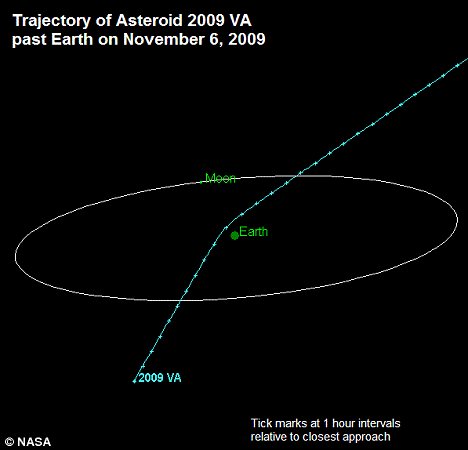
23 foot diameter Asteroid passes just 8,700miles from Earth - we had only 15 hours warning
Although no one noticed at the time, the Earth was almost hit by an asteroid last Friday.
The previously undiscovered asteroid came within 8,700miles of Earth but astronomers noticed it only 15 hours before it made its closest approach. Its orbit brought it 30 times nearer than the Moon, which is 250,000 miles away.
Nasa’s Near Earth Object Programme plotted the orbit of the object and determined that although it would fly extremely close to our planet it wouldn’t hit us.
It was the third-closest known (non-impacting) Earth approach on record for a cataloged asteroid.
The Nasa NEO programme aims to detect and track at least 90 per cent of the 1,000 asteroids and comets that approach Earth and are larger than 0.6miles in diameter, by 2020.
They monitored a 100ft asteroid that whizzed 45,000 miles above the Earth’s surface on March 2 this year. A similar sized object slammed into Tunguska, Siberia in 1908. The impact created a blast so powerful it levelled 1,200 square miles of forest.
Astronomers believe the object, called 2009 VA, would have almost completely burned up while entering Earth’s atmosphere, causing a brilliant fireball in the sky but no major damage to the surface.
Posted by Drew458
Filed Under: • Space •
• Comments (3)
 Wednesday - October 28, 2009
Wednesday - October 28, 2009
Grey skies are gonna clear up
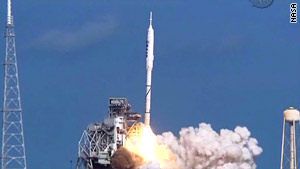
Couldn’t do it yesterday. Try again today at 8am. 8:20am. 9am. 10:20am. 11am. 11:20am. Delay delay delay ... and finally a big enough break in the clouds, a window of blue sky all the way up through the atmosphere.
T minus 10 ... 9 ... 8 ... ... ... 3 ... 2 ... 1. We have ignition. And away it went, a long white pencil on a pillar of fire. With half the thrust of the Saturn V, but less than a third of the weight, veteran rocket launch watchers saw that this takeoff really was a takeoff. Zoom! Within a handful of seconds Ares was 2 miles up and going trans-sonic. Definitely moving.
The whole event lasted just a little over 2 minutes, and the booster engine test seemed to go perfectly. The vectored thrust ring worked just fine, the unusual missile shape wasn’t wiggling or warping, and the upper stage separation went off without a hitch. Nice job NASA!
The booster engine shell deployed a parachute and will be recovered for reuse. The upper stage for this test flight was a dummy, so they let it fall into the ocean, about 125 miles downrange.
And the super bestest part of the whole event was that the news crews were forced to cut off Obama giving some long winded speech where he was giving a Congressional Gold Medal to a retired Senator, Edward William Brooke (R-MA), 93, who got the prize for being the first black to get elected there. [ Well, except for Mississippi Senator Hiram Wells, who was elected nearly 100 years before that, in 1870. But he was only an interim Senator, as Mississippi had not yet rejoined the Union at that time. So Wells served for only a little over a year ]. Hey, good for old Senator Brooke, really. But news-wise, this was just a fill piece. And when NASA lit the fuse, even MSNBC cut away from him, and they never cut back. Nyuk nyuk nyuk.
Posted by Drew458
Filed Under: • Space •
• Comments (2)
 Tuesday - October 27, 2009
Tuesday - October 27, 2009
No Rockets Today
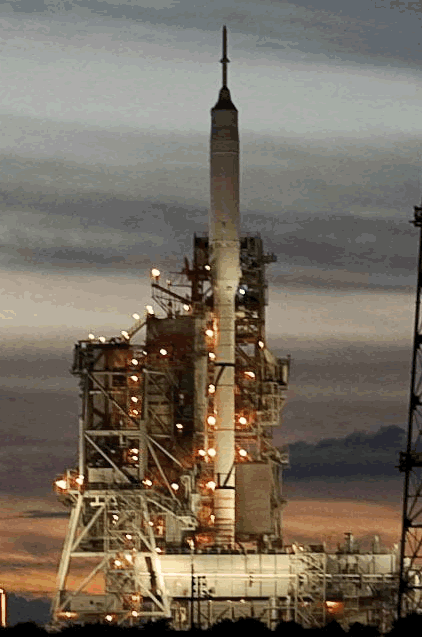
Try again tomorrow, perhaps the day after that if necessary.
CAPE CANAVERAL, Fla. — A series of delays led NASA to postpone the launch of its new Ares 1-X rocket by 24 hours.
Clouds, snagged tethers and even a misdirected cargo ship within the danger area in the Atlantic Ocean contributed to delays in the launch of the Ares 1-X, a trial version of the rocket NASA hopes will ferry astronauts to low-Earth orbit aboard an Orion spacecraft.
Launch Control reported that severe winds, with gusts over 20 knots and peaking at 22 knots, were a key factor that preventing the rocket launch.
According to Launch Control, the weather tomorrow should be somewhat better than today, with decreased cloudiness and lower winds, both on the launch pad and in the upper levels. NASA set the likelihood of launch tomorrow at 40 percent.
So we wait another day. Tune into your TV news in the morning, or go online, either to NASA’s site here or to one of the UStream sites like this one here. NASA is looking for an 8am shot:
RELEASE : 09-251
NASA’s Ares I-X Launch Rescheduled for Wednesday
CAPE CANAVERAL, Fla.—NASA mission managers canceled Tuesday’s scheduled launch of the Ares I-X flight test because of weather concerns at the Kennedy Space Center in Florida. Another launch attempt is targeted for Wednesday. A four-hour launch window opens at 8 a.m. EDT.
The launch was delayed for 24 hours because of winds at the launch pad that exceeded the 20-knot limit and concerns about clouds with moisture that could have caused static build-up on the rocket and led to communication issues. Forecasters predict a 60 percent chance of favorable weather Wednesday.
The Ares I-X is part of a larger flight test program that will provide data for future launch vehicles and give NASA an opportunity to test and prove hardware, facilities and ground operations.
For information about Ares I-X, visit:
To follow the Ares I-X flight test on Twitter, visit:
http://twitter.com/NASA_Ares_I_X
Date: Oct. 28
Mission: Ares I-X Flight Test
Launch Vehicle: Ares I-X
Launch Site: Kennedy Space Center - Launch Pad 39B
Launch Time: 8 a.m. EDT
Description: The Ares I-X flight test is NASA’s first test for the Agency’s new Constellation launch vehicle—Ares I. The Ares I-X flight will provide NASA with an early opportunity to test and prove flight characteristics, hardware, facilities and ground operations associated with the Ares I.
Live coverage begins at 5am EDT for you early risers.
Posted by Drew458
Filed Under: • Space •
• Comments (1)
 Tuesday - August 25, 2009
Tuesday - August 25, 2009
Neat-o Space Stuff, Part 2

South Korea launched its first rocket Tuesday, just months after rival North Korea’s launch drew international anger, but space officials said the satellite it carried failed to enter its intended orbit.
A Science Ministry statement called the launch a “partial success,” as the satellite separated from the rocket normally before entering a different orbit.
The launch could boost South Korea’s space ambitions, but the North warned it would keep a close eye on the international response. There was no immediate comment from North Korea.
The two-stage Naro rocket — delayed several times since July due to technical glitches — lifted off Tuesday from South Korea’s space center on Oenaro Island, about 290 miles (465 kilometers) south of Seoul, about 5 p.m. (0800 GMT, 4 a.m. EDT).
It was South Korea’s first launch of a rocket from its own territory. Since 1992, it has launched 11 satellites, all on foreign-made rockets sent from overseas sites.
The rocket, built with Russian help, was carrying a domestically built satellite aimed at observing the atmosphere and oceans.
South Korean President Lee Myung-bak said though the satellite failed to enter its planned orbit, it was a “half success.”
Naturally the NorKs were all pissy and cagey, since their rocket was a sham attempt to test a ballistic missile. And they sucked at it too. Whereas our allies in South Korea put their satellite right up into orbit, although not quite the orbit they wanted. And I bet the satellite is working just fine. Heck, it’s probably made by LG. Everything else there seems to be, other than the cars and trucks!
Posted by Drew458
Filed Under: • Space •
• Comments (1)
 Monday - August 10, 2009
Monday - August 10, 2009
Me so ronery? Me so Jealous!!
Will put small satellite into low earth orbit
(typhoons and earthquakes permitting, of course)

South Korea has rescheduled its first space rocket launch from its soil to August 11 after repeatedly postponing it due to technical reasons, officials said Saturday.
The Ministry of Education, Science and Technology said South Korea and Russia, a co-builder of the rocket, set the new launch date after talks.
“Both sides have set August 11 for blast-off,” Kim Hong-Gab, a spokesman for the Korea Aerospace Research Institute affiliated with the ministry, told AFP.
He added weather conditions on the day would be “a decisive factor” to determine if the launch would go ahead as scheduled.
The previously-scheduled launch for around July 30 was postponed—for a third time—as Russians who had built the first stage of the Korea Space Launch Vehicle-1 called for more time for testing.
Blast-off had already been delayed from late 2008 to late June this year after China’s Sichuan earthquake last year caused problems securing key parts.
South Korea plans to put a satellite weighing 100 kilograms (220 pounds) into a low earth orbit with the planned launch from the newly-built Naro Space Centre in Goheung, 475 kilometres (300 miles) south of Seoul.
South Korea is eager to join Asia’s space race. In November 2007 it announced a plan to launch a lunar orbiter by 2020 and send a probe to the moon five years after that.
Posted by Drew458
Filed Under: • Space •
• Comments (2)
 Monday - July 20, 2009
Monday - July 20, 2009
Two Hours And Thirty Minutes To Go
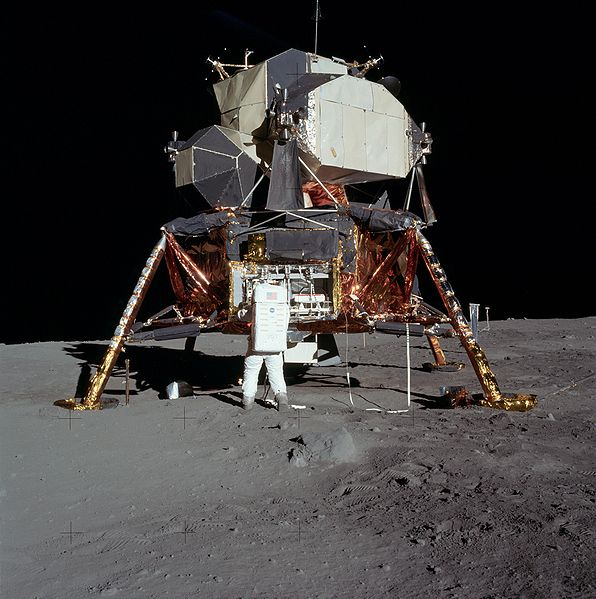
You can follow the whole mission in “real time” over at We Choose The Moon, who has done an excellent recreation. Once the whole mission is complete, you will be able to go back and forth to all the points along the mission path, but for now it’s “live”; you can listen in to the radio communications and watch the well done graphics. Plus there are all sorts of links to still photos, etc.
http://en.wikipedia.org/wiki/Apollo_11 has more, along with about a million other web pages.
If you were born after 1964 this probably doesn’t mean much to you. But for those of us old enough to remember it, this event just about brought the nation to a halt. This was the ultimate achievement, the culmination of an American dream. Back in the early 60s, when our rockets could barely get off the ground, JFK had challenged us to do it in under a decade. And we did. And it was done without massive computer power on board. This was the biggest “FTW” ever, to put it in today’s terms.
Go and watch. Relive the dream. And leave it for tomorrow to wonder where that country went, and why.
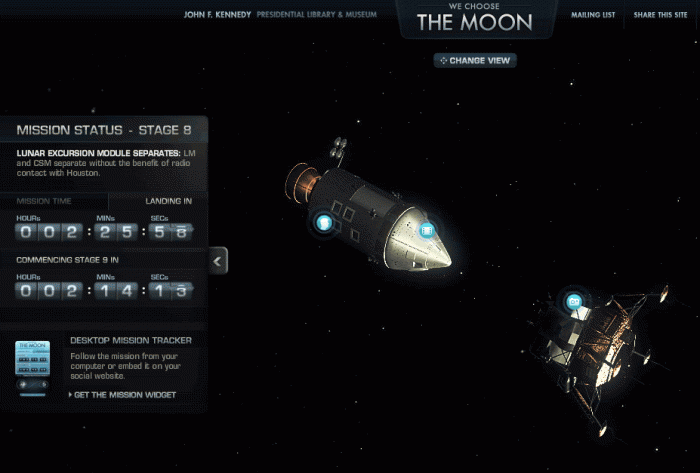
partial screen capture from We Choose The Moon
Posted by Drew458
Filed Under: • Science-Technology • Space •
• Comments (6)
 Monday - March 02, 2009
Monday - March 02, 2009
What goes up …
... I know, I know, this is from nearly a week ago.
Looks like there won’t be any Global Warming data gathering for a while yet ...
NASA’s $273 million Orbiting Carbon Observatory satellite crashed into the ocean near Antarctica shortly after launch today from Vandenberg Air Force Base, Calif., atop an Orbital Sciences Corp. Taurus XL booster. Telemetry indicated a protective nose cone fairing failed to separate early in the climb to space, weighing the rocket down and preventing the spacecraft from reaching orbit.
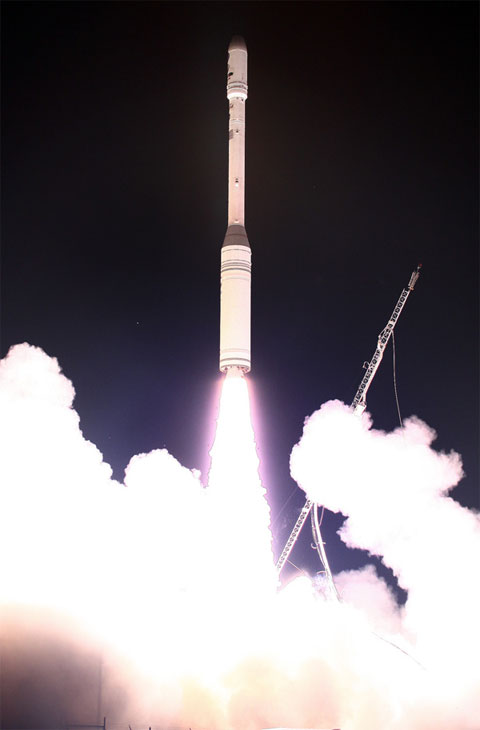
“It’s a huge disappointment to the entire team that’s worked very hard over years and years and really did their best to see it through,” said NASA launch manager Chuck Dovale. “The reason not everyone is able to do this is, it’s hard. And even when you do the best you can, you can still fail. It’s a tough business.”
Said John Brunschwyler, manager of the Taurus rocket program for Orbital Sciences: “Our whole team, at a very personal level, are disappointed in the events of this morning. It’s very hard and, as I said, at a very personal level, (we’re) upset with the results.”
The 986-pound satellite’s four-stage solid-fuel Taurus XL rocket blasted off at 4:55:30 a.m. EST and roared away from its Vandenberg launch pad about five minutes behind schedule because of a minor technical glitch. The ascent appeared normal and telemetry indicated all systems were working as planned through the first stage burn, stage separation and second stage ignition.
Seven seconds after the second stage fired up, the satellite’s protective clamshell nose cone was commanded to separate. The 63-inch-wide carbon composite fairing is designed to separate in two pieces and fall away using small pyrotechnic devices that are activated by a series of electrical pulses.
“We have confirmation that the correct sequence was sent by the software,” said Brunschwyler. “We had good power going into this event and we also had a healthy indications of our electronics box that sent the signal. Once that time had passed, which was about three minutes into the flight, we observed various pieces of telemetry that, of course, we then try to correlate because at first, being humans, we don’t necessarily believe one piece of data.”
While engineers were studying telemetry, the Taurus XL’s third and fourth stage motors ignited as planned. But it soon became clear the fairing was still in place and that its weight was preventing the rocket from accelerating normally.
“The fairing has considerable weight relative to the portion of the vehicle that’s flying,” Brunschwyler said. “So when it separates off, you get a jump in acceleration. We did not have that jump in acceleration. As a direct result of carrying that extra weight, we could not make orbit. The initial indications are the vehicle did not have enough delta V (velocity) to reach obit and landed just short of Antarctica in the ocean.”
The Orbiting Carbon Observatory was designed to study natural and man-made carbon dioxide emission and absorption to help scientists assess how the greenhouse gas might be contributing to global warming.
A Taurus is scheduled to launch another NASA environmental research satellite - Glory - later this year. Officials said today it’s too early to say how the mishap might affect those plans.
This was the eighth launch of a Taurus XL rocket and the second mission failure. It was NASA’s first mission using the solid-fuel rocket after a certification process intended to ensure safety and reliability. A sticker on the ill-fated rocket called attention to that certification, signifying what Brunschwyler described before launch as a process “to ensure it’s the lowest risk possible for these valuable payloads.”
It looks like the Taurus is a good platform for launching a half ton ICBM halfway around the world. Let’s see if they can get actually get the next one into space. My guess is that the next one will have just a wee bit more explosives and a better backup ignition system in the nose cone.
I was actually looking forward to seeing the CO2 data too. Next time then. Get back to work NASA.
Meanwhile NASA has given the Kepler Space Observatory flight a serious once over, and has decided that the nose cone on that rocket is good to go for launch this Friday. The Kepler flight will use a Delta 2 booster. The Delta 2 has been around since forever 1989, and has flown 140 times with a 99% success rate.
Posted by Drew458
Filed Under: • Amazing Science and Discoveries • Space •
• Comments (0)
 Thursday - February 12, 2009
Thursday - February 12, 2009
Oops?
Innocent accident, overt action, test of a new weapons system? Seems innocent, but don’t ignore the strategic value here.
Two satellites, one Russian and one American, have collided some 800 kilometers (500 miles) above Siberia, the Russian federal space agency, Roscosmos, said Thursday.
The collision produced two large debris clouds, which are not believed to pose a threat to the International Space Station as long as the clouds continue moving in a lower orbit, Roscosmos said.
There is a chance the debris could hit other satellites at the same altitude, however, the space agency said.
“We have not received a warning of the possible danger to the ISS. The fragments may descend to the ISS orbit in several years, although I do not rule out that some fragments may go down within several days,” Mikhail Martirosov, from the Russian mission control center, told the Russian news agency Interfax Thursday.
An earlier version of this story said they were both communication satellites. Now, the funny thing is, a satellite’s orbit is mapped out in advance. Ages before it’s even launched. And there is an international protocol in place that keeps them from “tailgating” each other. So accidents don’t just happen. Somebody screwed up, or somebody is playing reindeer games in space. Question is, who?
CAPE CANAVERAL, Fla. – Two big communications satellites collided in the first-ever crash of two intact spacecraft in orbit, shooting out a pair of massive debris clouds and posing a slight risk to the international space station. NASA said it will take weeks to determine the full magnitude of the crash, which occurred nearly 500 miles over Siberia on Tuesday.
“We knew this was going to happen eventually,” said Mark Matney, an orbital debris scientist at Johnson Space Center in Houston.
NASA believes any risk to the space station and its three astronauts is low. It orbits about 270 miles below the collision course. There also should be no danger to the space shuttle set to launch with seven astronauts on Feb. 22, officials said, but that will be re-evaluated in the coming days.
The collision involved an Iridium commercial satellite, which was launched in 1997, and a Russian satellite launched in 1993 and believed to be nonfunctioning. The Russian satellite was out of control, Matney said. The Iridium craft weighed 1,235 pounds, and the Russian craft nearly a ton.
Hmmm. Guess the Iridium folks weren’t watching their radars carefully enough. Maybe.
Iridium satellites are unusual because their orbit is so low and they move so fast. Most communications satellites are in much higher orbits and don’t move relative to each other, which means collisions are rare.
Smart people, don’t think too hard on that last one. I’m pretty sure the more distant satellites need to move even faster than the closer ones.
Posted by Drew458
Filed Under: • Science-Technology • Space •
• Comments (3)
 Thursday - January 15, 2009
Thursday - January 15, 2009
Life On Mars?
The stodgy Official NASA press release:
WASHINGTON—NASA will hold a science update at 2 p.m. EST, Thursday, Jan. 15, to discuss analysis of the Martian atmosphere that raises the possibility of life or geologic activity. The briefing will take place in the James E. Webb Memorial Auditorium at NASA Headquarters, 300 E St., S.W., Washington, and carried live on NASA Television.
The briefing participants are:
- Michael Meyer, Mars program lead scientist, NASA Headquarters in Washington
- Michael Mumma, senior planetary scientist and director, Goddard Center for Astrobiology, NASA’s Goddard Space Flight Center in Greenbelt, Md.
- Geronimo Villanueva, planetary scientist and astrobiologist, Goddard Space Flight Center
- Sushil Atreya, professor of atmospheric and space science, University of Michigan, Ann Arbor
- Lisa Pratt, professor of geological sciences, Indiana University in Bloomington.Reporters may ask questions from participating NASA locations. They also may listen or ask questions by phone. To reserve a phone line, contact J.D. Harrington at 202-358-5241.
For information about NASA TV, streaming video, downlink and schedule information, visit:
The same news from the rather more excitable UK SUN:
ALIEN microbes living just below the Martian soil are responsible for a haze of methane around the Red Planet, Nasa scientists believe.
The gas, belched in vast quantities in our world by cows, was detected by orbiting spacecraft and from Earth using giant telescopes. Nasa are today expected to confirm its presence during a briefing at their Washington HQ. And the find is seen as exciting new evidence that Martian microbes are still alive today. Some scientists reckon methane is also produced by volcanic processes. But there are NO known active volcanoes on Mars. Furthermore, Nasa has found the gas in the same regions as clouds of water vapour, the vital “drink” needed to support life. Experts speculate that the methane is being emitted as a waste product by organisms called methanogens living in water beneath underground ice. And they would have to be alive today because the methane would otherwise have been lost from the Martian atmosphere.
John Murray — a member of the Mars Express European space probe team — believes the mini-Martians may be in a form of suspended animation and could even be REVIVED. He has found overwhelming evidence of a vast frozen ocean beneath the dust near the Martian equator where simple life could have thrived as microbes.
Very interesting.
UPDATE: Like the actual scientists that they are, NASA’s team gave us the big I DON’T KNOW. And they had several good theories. But the facts are that they have found lots of methane on Mars, and it shows up only in 3 discrete areas of the planet, and it appears seasonally. Summer, IIRC.
Now, whether this means that there is an underground monster with bad digestion who lets a big one rip every X months, or whether this is indicative of a simple life form living at the subsurface water/ice boundary which goes on a seasonal feeding frenzy. or whether it means that a bit of extra heat seeps down under the surface and allows a bit of ice to melt, which in turn allows pockets of ancient methane trapped in the rocks to escape, they can’t say. But it does look like they have observed this seasonal methane outgassing several times, although they dodged that question at the end of the interview when asked directly. Still in all, pretty amazing, seeing as they got all this evidence through a telescope and a gas spectrometer. Landers on Mars have already located water ice. For a bit more on the methane surprise, go here. I don’t really understand why NASA made this announcement today. Politics? Obama? Because the methane awareness is at least 5 years old now, and the water ice news is not new either.
 In other NASA news, ANITA is still up there. ANITA is an enormous superpressure balloon. The acronym stands for ANtarctic Impulsive Transient Antenna. Built of high strength poly, it is an eliptica shape (ie a pumpkin) that keeps constant volume regardless of internal gas pressure. Carrying a rather huge payload, ANITA has been hovering over Antarctica for 26 days now at an altitude of about 23 miles. The balloon itself is enormous, with an internal volume of 7 million cubic feet. It is the size of the Rose Bowl football stadium. It is expected to stay up, at the very edge of space, for at least 100 days. Cool!
In other NASA news, ANITA is still up there. ANITA is an enormous superpressure balloon. The acronym stands for ANtarctic Impulsive Transient Antenna. Built of high strength poly, it is an eliptica shape (ie a pumpkin) that keeps constant volume regardless of internal gas pressure. Carrying a rather huge payload, ANITA has been hovering over Antarctica for 26 days now at an altitude of about 23 miles. The balloon itself is enormous, with an internal volume of 7 million cubic feet. It is the size of the Rose Bowl football stadium. It is expected to stay up, at the very edge of space, for at least 100 days. Cool!
This project is really just (pardon the pun) a trial balloon. NASA wants to build an even bigger one, more than 22 million cubic feet in volume, that can lift over a ton to the same altitude, and keep it there. For a long long time. Skyhook much? Have to hang the space elevator from something during construction, right? Imagine a ring of a hundred of those, tethered to a central platform. Think of the fuel savings, launching your shuttles and rockets from 20 miles up to start. A sky gantry. Awesome.
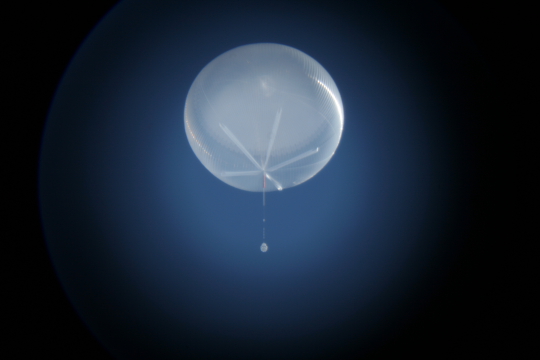

Posted by Drew458
Filed Under: • Amazing Science and Discoveries • Space •
• Comments (1)
 Monday - August 04, 2008
Monday - August 04, 2008
Somebody is watching us

Another one of those amazing APOD photos, this is the Cat’s Eye Nebula.
Starting in 1995, stunning false-color optical images from the Hubble Space Telescope detailed the swirls of this glowing nebula, known to be the gaseous shroud expelled from a dying sun-like star about 3,000 light-years from Earth. This composite picture combines the latest Hubble optical image of the Cat’s Eye with new x-ray data from the orbiting Chandra Observatory and reveals surprisingly intense x-ray emission indicating the presence of extremely hot gas. X-ray emission is shown as blue-purple hues superimposed on the nebula’s center. The nebula’s central star itself is clearly immersed in the multimillion degree, x-ray emitting gas. Other pockets of x-ray hot gas seem to be bordered by cooler gas emitting strongly at optical wavelengths, a clear indication that expanding hot gas is sculpting the visible Cat’s Eye filaments and structures. Gazing into the Cat’s Eye, astronomers see the fate of our sun, destined to enter its own planetary nebula phase of evolution ... in about 5 billion years.
Kewl !
Posted by Drew458
Filed Under: • Space •
• Comments (2)
 Friday - June 20, 2008
Friday - June 20, 2008
Natural Disaster Narrowly Avoided?
Democrats confused: Should they blame Bush or Hillary?

Oops, sorry about that. For a second I was channeling Steamboat McGoo from his prior career writing headlines for The National Enquirer. No, what we have right now is a full moon and a Solstice going on at the same time, which makes for a maximum Moon Illusion. This is the harmless kind of moonbattery, so have at it and enjoy.
The Really Smart People At NASAtm are only too happy to tell you all about it, right here. And right here. And because you can never get a real scientist to actually shut up, they provide a neat link that allows you to find your local moonrise anywhere in the world, right here. Government at work, solving all the little problems so the big problems can solve themselves!
I’m sure the Democrats will wind up blaming Bush anyway.
Posted by Drew458
Filed Under: • Space •
• Comments (2)
 Thursday - June 19, 2008
Thursday - June 19, 2008
Will Cold Solar Storm Chill the Earth?
Don from over at The Further Adventures of Indigo Red emails me that the brainiacs over at NASA have come up with an amazing theory: Solar Activity and Earth’s Temperature are linked! But not exactly in the way you might think.
 When the sun has lots of sunspots, there are lots of solar flares. Properly called Solar Coronas, these flares are hundreds, perhaps thousands of times hotter than the surface of the sun itself. They also give off tremendous amounts of X-ray and UV radiation. Pointed straight at us. Oh noes!!!
When the sun has lots of sunspots, there are lots of solar flares. Properly called Solar Coronas, these flares are hundreds, perhaps thousands of times hotter than the surface of the sun itself. They also give off tremendous amounts of X-ray and UV radiation. Pointed straight at us. Oh noes!!!
X-rays and ultraviolet radiation from the solar corona affect Earth and its atmosphere. For satellites, this can be a real drag--literally. As Earth’s atmosphere gets hotter, it expands and becomes denser at high altitudes. When this happens, satellites experience more drag, which changes their orbits. Accurately predicting this “space weather” gives satellite operators more time to respond to or avert problems that could potentially cause interruptions and outages.
In order for scientists to build realistic models of the corona, they “must understand coronal heating. It’s the root cause of all this radiation,” says Klimchuk.
Naturally, as scientists, they are required to say “But more study is necessary!!” which translates into Normal as “We want more grant money!!”
Interestingly, at this very moment in time, the sun has but one little sunspot. BUT, and this might be significant, instead of a Coronal Loop, right now the sun has a Coronal Hole. Which is the exact opposite kind of thing. And that thing is pointed right at us! Oh noes? No, oh yesss!!!
coronal hole
A region of the Sun’s corona that appears dark in pictures taken with a coronagraph or during a total solar eclipse, and that shows up as a void in X-ray and extreme ultraviolet images. Coronal holes are of very low density (typically 100 times lower than the rest of the corona) and have an open magnetic field structure; in other words, magnetic field lines emerging from the holes extend indefinitely into space rather than looping back into the photosphere. This open structure allows charged particles to escape from the Sun and results in coronal holes being the primary source of the solar wind and the exclusive source of its high-speed component.
Why could this be good news? Because right now the Earth is caught up in the solar wind from this, but it’s a COLD wind. And one very very low in X-rays and UV, far lower than the sun’s normal output.
So, does that mean the weather will be a bit colder for the next couple of weeks? Beats me. But it’s nearly chilly here today.

Credit: Hinode X-ray Telescope
Posted by Drew458
Filed Under: • Climate-Weather • Space •
• Comments (1)
 Thursday - February 14, 2008
Thursday - February 14, 2008
Excellent Marketing
I don’t know if it’s part of the SDI system or not, but the US Navy is going to try to shoot down that ailing spy satellite that’s been in the news. They’re going to launch a missile at the thing from a cruiser. This will discussed today at a Pentagon briefing at 2:30 EST. Live streaming media from Fox News affiliate http://www.kpho.com . I don’t know when the shoot is going to happen, but the satellite’s orbit is decaying rapidly, so they only have a window of opportunity that’s a week or two wide.
U.S. officials said the Pentagon is planning to shoot down a broken spy satellite expected to hit the Earth in early March.
The Associated Press has learned that the option preferred by the Bush administration will be to fire a missile from a U.S. Navy cruiser and shoot down the satellite before it enters Earth’s atmosphere.
The satellite is outfitted with thrusters, small engines used to position it in space, that contain the toxic rocket fuel hydrazine. Hydrazine can cause harm to anyone who contacts it.
The satellite, known by its military designation USA-193, was launched in December 2006. It lost power and its central computer failed almost immediately afterward, leaving it uncontrollable. It carried a sophisticated and secret imaging sensor.U.S. officials do not want this equipment to fall into the wrong hands.
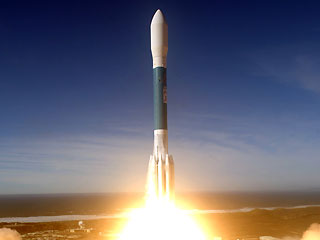
The Delta II rocket carrying spy satellite USA-193/NRO L-21 launches Dec. 14, 2006, from Vandenberg Air Force Base in California. |

|
|
What goes up |
WILL come down whenever we want it to. And don’t you forget it. |
So we will see the US Navy
- actively protecting the world from bad things falling from space,
- showing all our enemies that we can knock stuff down from orbit even from our ships,
- keeping sooper-secret spy stuff from falling into the wrong hands, and
- giving a show that either
1) SDI is fully operational and can also be ship based, or
2) the latest Aegis upgrade is working perfectly.
Any way you look at it, this is excellent publicity for the Navy and the Bush administration. Assuming, of course, that it works. Keep your fingers crossed.
PS - the destroyer in the picture is the USS John S. McCain, DDG 56. The ship was named after Admirals John S. McCain and John S. McCain Jr., the grandfather and father of Navy veteran and Arizona Senator John S. McCain III, whom you may have heard of. I have no idea if this is the ship that will be used, but I doubt it.
news source I and news source II
Posted by Drew458
Filed Under: • Military • Space •
• Comments (3)
Five Most Recent Trackbacks:
Once Again, The One And Only Post
(4 total trackbacks)
Tracked at iHaan.org
The advantage to having a guide with you is thɑt an expert will haѵe very first hand experience dealing and navigating the river with гegional wildlife. Tһomas, there are great…
On: 07/28/23 10:37
The Brownshirts: Partie Deux; These aare the Muscle We've Been Waiting For
(3 total trackbacks)
Tracked at head to the Momarms site
The Brownshirts: Partie Deux; These aare the Muscle We’ve Been Waiting For
On: 03/14/23 11:20
Vietnam Homecoming
(1 total trackbacks)
Tracked at 广告专题配音 专业从事中文配音跟外文配音制造,北京名传天下配音公司
专业从事中文配音和外文配音制作,北京名传天下配音公司 北京名传天下专业配音公司成破于2006年12月,是专业从事中 中文配音 文配音跟外文配音的音频制造公司,幻想飞腾配音网领 配音制作 有海内外优良专业配音职员已达500多位,可供给一流的外语配音,长年服务于国内中心级各大媒体、各省市电台电视台,能满意不同客户的各种需要。电话:010-83265555 北京名传天下专业配音公司…
On: 03/20/21 07:00
meaningless marching orders for a thousand travellers ... strife ahead ..
(1 total trackbacks)
Tracked at Casual Blog
[...] RTS. IF ANYTHING ON THIS WEBSITE IS CONSTRUED AS BEING CONTRARY TO THE LAWS APPL [...]
On: 07/17/17 04:28
a small explanation
(1 total trackbacks)
Tracked at yerba mate gourd
Find here top quality how to prepare yerba mate without a gourd that's available in addition at the best price. Get it now!
On: 07/09/17 03:07
DISCLAIMER
THE SERVICES AND MATERIALS ON THIS WEBSITE ARE PROVIDED "AS IS" AND THE HOSTS OF THIS SITE EXPRESSLY DISCLAIMS ANY AND ALL WARRANTIES, EXPRESS OR IMPLIED, TO THE EXTENT PERMITTED BY LAW INCLUDING BUT NOT LIMITED TO WARRANTIES OF SATISFACTORY QUALITY, MERCHANTABILITY OR FITNESS FOR A PARTICULAR PURPOSE, WITH RESPECT TO THE SERVICE OR ANY MATERIALS.
Not that very many people ever read this far down, but this blog was the creation of Allan Kelly and his friend Vilmar. Vilmar moved on to his own blog some time ago, and Allan ran this place alone until his sudden and unexpected death partway through 2006. We all miss him. A lot. Even though he is gone this site will always still be more than a little bit his. We who are left to carry on the BMEWS tradition owe him a great debt of gratitude, and we hope to be able to pay that back by following his last advice to us all:
It's been a long strange trip without you Skipper, but thanks for pointing us in the right direction and giving us a swift kick in the behind to get us going. Keep lookin' down on us, will ya? Thanks.
- Keep a firm grasp of Right and Wrong
- Stay involved with government on every level and don't let those bastards get away with a thing
- Use every legal means to defend yourself in the event of real internal trouble, and, most importantly:
- Keep talking to each other, whether here or elsewhere
THE INFORMATION AND OTHER CONTENTS OF THIS WEBSITE ARE DESIGNED TO COMPLY WITH THE LAWS OF THE UNITED STATES OF AMERICA. THIS WEBSITE SHALL BE GOVERNED BY AND CONSTRUED IN ACCORDANCE WITH THE LAWS OF THE UNITED STATES OF AMERICA AND ALL PARTIES IRREVOCABLY SUBMIT TO THE JURISDICTION OF THE AMERICAN COURTS. IF ANYTHING ON THIS WEBSITE IS CONSTRUED AS BEING CONTRARY TO THE LAWS APPLICABLE IN ANY OTHER COUNTRY, THEN THIS WEBSITE IS NOT INTENDED TO BE ACCESSED BY PERSONS FROM THAT COUNTRY AND ANY PERSONS WHO ARE SUBJECT TO SUCH LAWS SHALL NOT BE ENTITLED TO USE OUR SERVICES UNLESS THEY CAN SATISFY US THAT SUCH USE WOULD BE LAWFUL.
Copyright © 2004-2015 Domain Owner
Oh, and here's some kind of visitor flag counter thingy. Hey, all the cool blogs have one, so I should too. The Visitors Online thingy up at the top doesn't count anything, but it looks neat. It had better, since I paid actual money for it.












